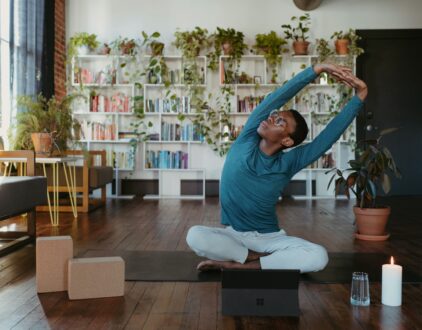Learning how to care for your mind is more important than ever before, and as you may already know, one powerful way to maintain good mental health is through meditation. Not only does it provide a number of health benefits like reducing stress and anxiety, but it also helps build confidence and self-esteem. And what better way to turn that practice into a habit than by designing your very own meditation room at home? If you want to learn how to take charge of your mental health, here are eight things you need to create a DIY meditation room.
Cushions
In order for meditation to work, you need to be super comfortable. That means incorporating lots of cushions and pillows that properly support your body. You can shop for soft and comfortable seating options at your local store or use a couple of pillows you have at home.

Blankets
Security blankets aren’t just for kids; adults can reap the benefits that a soft, cozy blanket provides, too. Where better to wrap yourself in a warm hug than inside your meditation room? Shop for weighted blankets, throw blankets, and shawls for a convenient way to put your mind and body at ease.
Timer
Without a timer, it can be easy to not stick to a designated length of time or to lose track of how much time you’ve spent meditating. To avoid this, use a timer to ensure you stick to your schedule.

Lighting
Lighting plays a big role in your mood, which is why having appropriate lighting is important if you want to get the most out of your meditation room. Invest in your mental health by installing soft, warm lighting like Himalayan salt lamps, string lights, or candles for a relaxing vibe.
Decor
You can add personality to your meditation room by incorporating decor designed to calm the mind such as tabletop fountains, lava lamps, or Japanese zen sand gardens.
Plants
For many people, nature is a calming and grounding force. If you have an appreciation for The Great Outdoors, consider decorating your meditation room with a low-maintenance houseplant like a succulent or snake plant. Not only does this help create a calming, natural ambiance, but it also helps improve the air quality in your room.

Aromatherapy
Aromatherapy is a powerful part of the meditation experience that you can use to help relax, energize, and relieve your mind. The great thing about aromatherapy is that there are many ways to practice it. For example, you could use an oil diffuser to infuse the air with soothing scents like lavender, chamomile, or eucalyptus, or you could create a ritual out of it by lighting scented candles or incense for a calming atmosphere.
Soundscape
Incorporating sound as part of your practice is useful not only for blocking out distractions, but calming the mind, too. You can reduce annoying disruptions by playing soft music, guided meditations, or nature sounds. You may even opt for a device that can do it all, like a white noise machine, to create a tranquil soundscape for your meditation space.

Journal
After you’re finished meditating, it’s always a good idea to write down your post-meditation reflections so you can track your progress going forward. You can do this by jotting down your thoughts in a journal. If you prefer a less involved approach, use a voice recording app to conveniently record your reflections following your meditation session.
popular posts
- 1It’s Black Business Month, So Let’s Go Shopping and #BuyBlack!
- 2These Home Decor Items Will Instantly Make Your Space Look Outdated
- 3Black-Owned Home Decor Stores To Support Across the United States
- 4A Look Inside Elon Musk's Tiny $50,000 House
- 57 Black and Multicultural Designers To Follow For Design Inspo
Spaces
Whether it’s luxury or ease, every area of your home should be as fabulous and unique as you.

Top 7 Essential Oils to Promote Wellness in Your Home
by Melody Beuzelin | April 18, 2023
FOLLOW ALONG ON INSTAGRAM
#homeandtexture
Find us on social for more home inspiration where culture, personal style, and sophisticated shopping intersect to help you create a home where you love to live.







